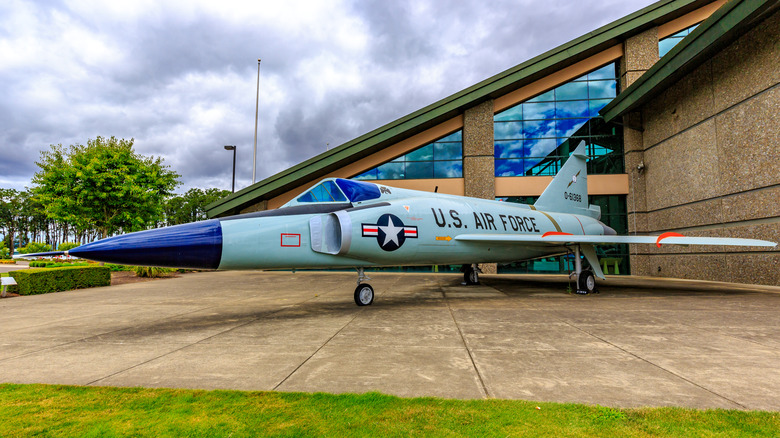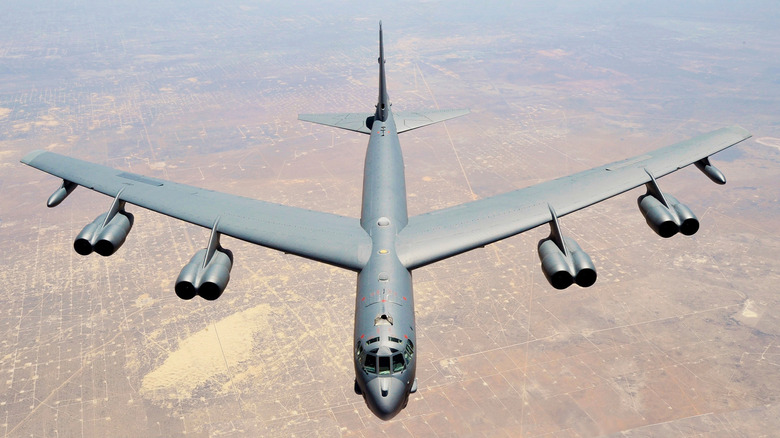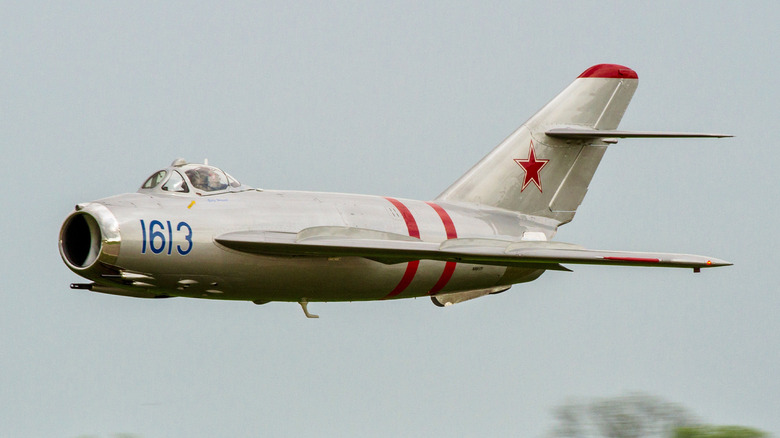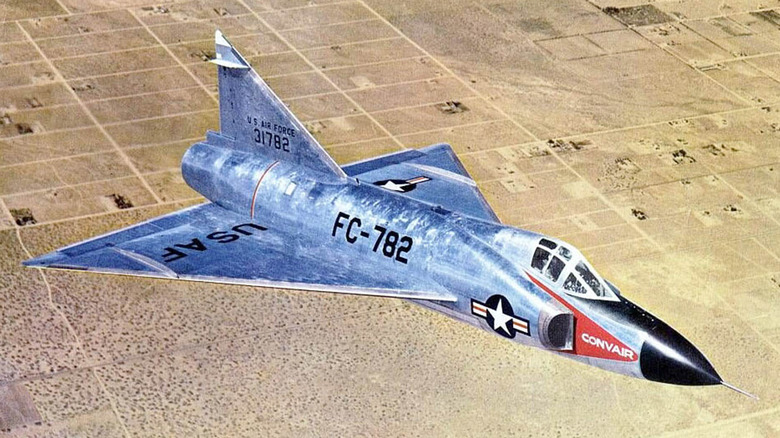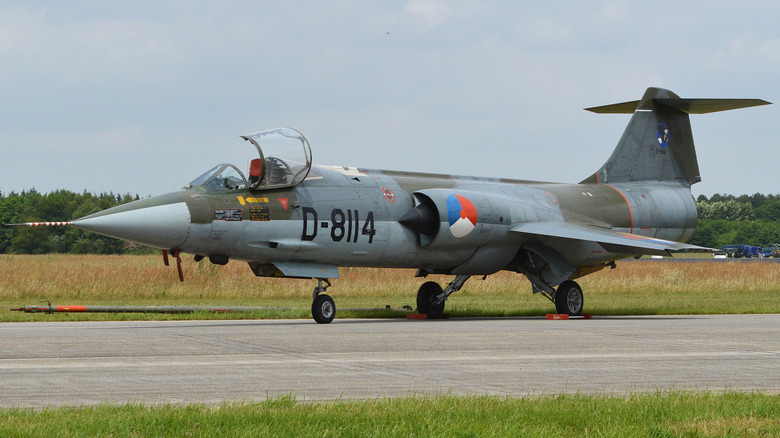5 Of The Worst Combat Jets To Fly In The Vietnam War
It's no secret that the Vietnam War was a rough time in U.S. history. Between the military's lack of preparedness for guerrilla warfare, waning support on both sides of the ocean, and North Vietnam's resilience, it was a pretty bad loss for U.S. forces.
However, one part of the war that is discussed less often is the battle that took place over the skies. During the Korean War, U.S. pilots mainly used the F-86 Sabre and ran up to an 8-to-1 kill ratio, dominating the skies. During Vietnam, that ratio dropped to 2.1 to 1 during the early days of the war. One of the reasons for that was because some of the jets used in the war weren't up to the task.
Indeed, the Vietnam War had some of the worst fighter jets ever flown by the U.S. Air Force. Add to that the slew of failed operations — many involving jets — and you end up with one of the worst air performances of any war in U.S. history. It's not necessarily that the jets were bad. The issue was that the jets were built for a different kind of war than the one fought in Vietnam, which meant that many U.S. fighter jet went into that war at a disadvantage.
We'll get into it more below, but suffice it to say that most of the worst combat jets to fly in Vietnam were flown by U.S. pilots, and that's one of the reasons the U.S. had such a rough time in that war.
B-52 Stratofortress
The B-52 Stratofortress was one of the cornerstones of the U.S. Air Force during the Vietnam War. It is a massive bomber that could drop tons upon tons of bombs in a very short period of time. It was built for long range missions, to carry nuclear armaments, and stay well above enemy radar. In fact, this is actually one of the best bombers in the U.S. arsenal and has been used in tons of conflicts from Vietnam to Desert Storm. For Vietnam, however, it was a part of one of the darkest parts of the war.
Also known as the Christmas Bombings, Operation Linebacker II it was an awful event for everyone involved. Over 200 B-52s dropped bombs during a campaign that lasted for 12 days, and the bombers flew 730 total missions. The damage to Vietnam was unfathomable, while the U.S. Air Force also sustained heavy losses that included 15 B-52 bombers, with six lost in a single day. The heavy losses were attributed to the bombers flying the same paths every night, which made them easy targets for ground defenses. The Air Force eventually switched things up, but not before taking heavy losses.
The number lost also varies based on who you ask. Officially, the military says only 15 were lost, but Vietnam claims as many as 31 were shot down in total. If true, that means 15% of all B-52s involved in Operation Linebacker II were lost during the operation.
Mikoyan-Gurevich MiG-17
Next, let's talk about the worst jet available to the North Vietnamese during the war — the Mikoyan-Gurevich MiG-17.
In truth, this fighter jet wasn't half bad, even if it doesn't quite stack up with the best fighter jets ever made. It was smaller and more agile than U.S. fighter jets of the time, including the excellent F-4 Phantom. Thanks to its smaller size and higher agility, North Vietnam was able to use the plane with exceptional efficiency. The U.S. still shot down more planes than North Vietnam, but the U.S. was far less successful against North Vietnam than it was in Korea.
However, that doesn't mean the MiG-17 was all that great. It began production in the early 1950s, so it was much older than the other fighter jets in the war. Its technology was old, and the planes themselves were old. The only reason they had an advantage at all was because the F-4 Phantom was designed to intercept bombers at long range and not conduct dogfights with smaller, more agile aircraft.
Despite those size and agility advantages, the MiG-17 was still not totally up to the task, posting a losing record against U.S. forces. North Vietnam would get the far superior MiG-21 later in the war, which performed substantially better. As the war continued, the MiG-17 eventually fell to an 8.33 to 1 kill ratio against U.S. forces, making it the worst jet North Vietnam had during the war.
F-102 Delta Dagger
The Convair F-102 Delta Dagger is where things really start to go sideways. Up until now, the other planes were fine or good but were used incorrectly or were just old. The F-102 Delta Dagger was objectively a difficult plane for the U.S. Air Force to use during the Vietnam War. For starters, it was designed as an interceptor during the Korean War. So, it was about as old as the MiG-17 when Vietnam came around, making it one of the older fighter jets in the Air Force's arsenal during that time.
What made the Delta Dagger bad was the hilarious number of revisions the fighter jet needed to reach its claimed performance. Early renditions were unable to achieve Mach 1, making it subsonic until future revisions were able to finally achieve supersonic speeds. However, it never really overcame its various limitations, making it one of the worst fighter jets ever made. It was handily outperformed by the F-4 Phantom and other fighters in the lineup, and its aging tech didn't help things.
For the most part, the F-102 was relegated to defense and escort missions during Vietnam with the actual fighting going to more advanced jets. It lost its only air-to-air combat of the war when one was shot down by a MiG-21 that got away safely. The F-102 was also used in many air-to-ground attacks. After the war, F-102s were converted to target drones, mimicking the movements of MiG-21s to give Air Force pilots training.
F-104 Starfighter
In another life, the F-104 Starfighter could've been a pretty good jet. It started development during the Korean War and was one of the first Mach 2 fighter jets in the U.S. Air Force arsenal. However, this plane got off on the wrong foot. In early development, it suffered a number of accidents, many of them being fatal. Most of them were due to inexperienced or over-confident pilots who couldn't control the sheer power of the F-104.
Accidents aside, the fighter was also ill-equipped to handle Vietnam. It was built for short-range missions and fights whereas Vietnam required more long-range combat, putting the F-104 at a disadvantage. In addition, multiple issues like flameouts, oil leaks, and other backfires were reported, but those were later fixed. Earlier, we talked about how the MiG-17 was more agile than fighters the U.S. Air Force had at the time, and this is where we come full circle on that. The F-104 was fast, but not agile, and in short-range dogfights, the MiG-17 was superior.
Combat losses were fairly minimal overall, but the F-104 Starfighter was considered mostly ineffective in Vietnam. It had its moments, but it was regularly outperformed by other fighters.
F-105 Thunderchief
That leaves us with the F-105 Thunderchief — easily the worst jet in the Vietnam War, and we have the stats to back it up. Like most of the U.S. arsenal, it was designed as a bomber during the Korean War era, making it ill equipped to handle the types of missions it flew during Vietnam. It had its first flight in 1955 and joined the Air Force a few years later.
A total of 833 of these were built for the Air Force, which includes all variants. However, the U.S. military acknowledges that the Air Force lost 334 F-105s in combat operations during Vietnam, which is more than all other fighter jets during that time and 20% of all U.S. Air Force losses over the entire war.
Part of the reason for these heavy losses was that the aircraft was mostly used in air-to-ground attacks. It reportedly flew over 20,000 combat missions overall. During that time, it recorded just 27.5 air-to-air kills, another example of the MiG-17's agility making them surprisingly hard to catch and destroy. Tack on the additional 63 F-105 losses due to accidents or malfunctions, and a little under half of all F-105s saw their end in Vietnam.
When the F-4 came out, it was designed to replace the F-105 Thunderchief, which it eventually did. The final F-105 was withdrawn from service after the war in 1980.
